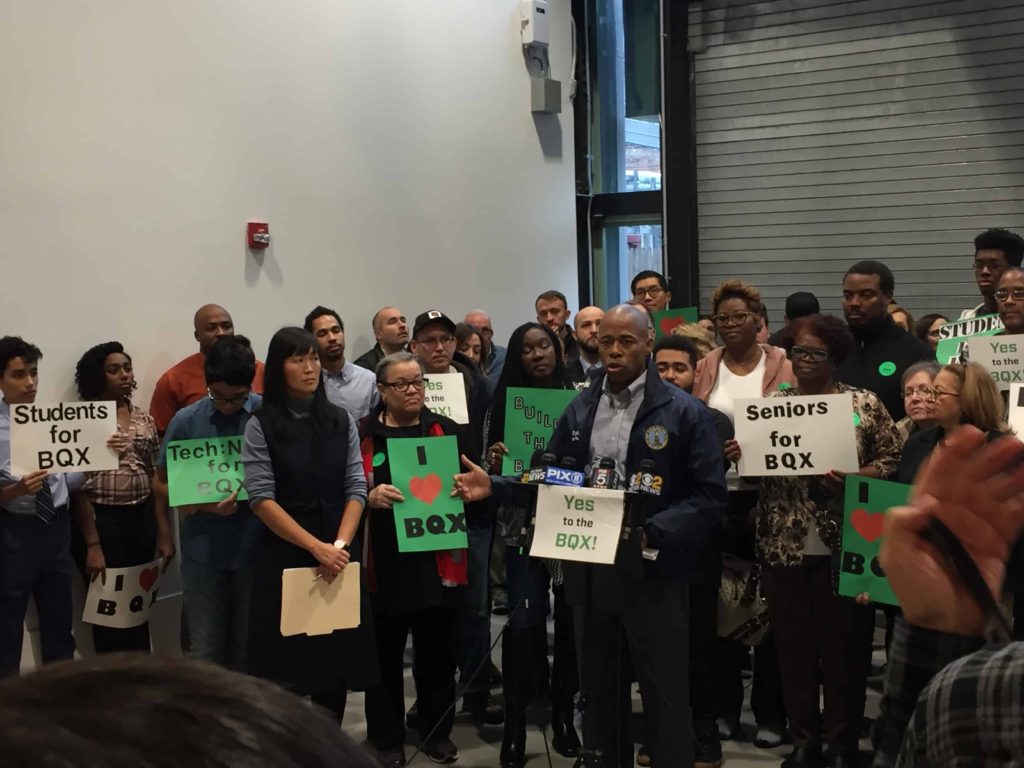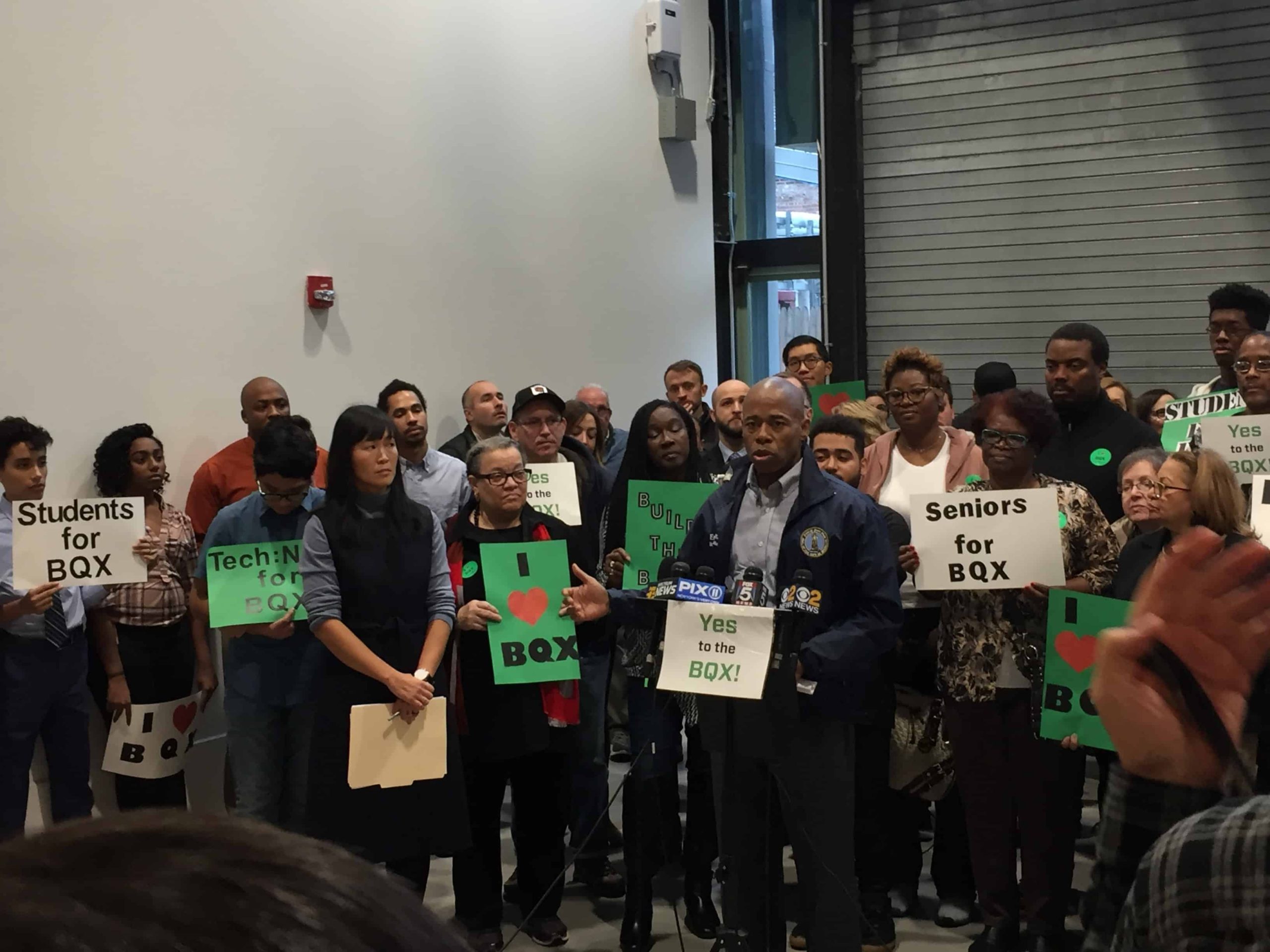
The latest ploy by the real-estate lobbying group, Friends of the Brooklyn Queens Connector, took place in November at the Brooklyn Navy Yard.
The BQX plan is to have NYC pay for a sleek-looking modern streetcar service along the Brooklyn/Queens waterfront—a waterfront that is in danger of transforming from mixed use to luxury residential development. The BQX would serve this transformation in much the same way that the Brooklyn Bridge Park has paved the way for luxury condo development along the Brooklyn Heights harbor—piers that once harbored ships and industry.
Appearing at the event was Brooklyn Borough President Eric Adams. He used Red Hook’s lack of subway service to make the case for the trolley—which actually would not provide transfers to the subway system.
Supporting Adams were representatives of the local tenant associations as well as the Red Hook Initiative (RHI), who have been supporting the BQX since the mayor first announced the idea at a press conference at Pioneer Works.
The Friends of the BQX is chaired by Jed Walentas, son of the founder of Two Trees, a real estate development company that is currently building over 2000 luxury apartments on the Williamsburg waterfront. Also on their board is Jill Eisenhard, Executive Director of RHI, who is the secretary, and Michelle de la Uz, Executive Director of the Fifth Avenue Committee, who serves as the Vice-Chair.
A prototype BQX car was unveiled after everyone gave their pumped-up remarks, endorsing the BQX to a house packed with supporters.
According to the Friends of the BQX, the trolley would by NYC’s most significant transit project in decades. It would connect 400,000 residents and 300,000 workers between Sunset Park and Astoria to booming, yet isolated, employment hubs along the waterfront. The project would cost a minimum of $2.5 billion. An original study determined that adding bus service providing equal benefit would only cost $1 billion.
This system would run on city streets for 14 miles along the shoreline. The speakers all pointed out reasons to support the project—a project that has not drawn the support of many community groups along the route, including Red Hook’s Civic Association as well as Sunset Park’s Uprose.
“Things like curb level boarding will open up access for New Yorkers with any sort of mobility issue,” Ya-Ting Liu, the Executive Director said.
Liu is paid just under $140,000 a year by the non-profit group, for an average 15 hour work-week, according to their latest tax filing.
“It is going to have open gangways and much more room and carrying capacity so that we can move New Yorkers efficiently and get them to their appointments, their work, job interviews and school faster and in a reliable way,” Liu continued.
Here to help
“Today we’re providing New Yorkers with their first real taste of what the BQX would look like and feel like, and calling on the city to bring light rail service to areas long underserved by reliable mass transit,” Liu said.
According to the Friends of the BQX group, the specific route is not known yet because they are waiting for the city to release a feasibility analysis. The route study area map has the trolley going through or close to Sunset Park, Gowanus, Red Hook, Downtown Brooklyn, DUMBO, the Navy Yard, Williamsburg, Greenpoint, Long Island City and Astoria.
“When the friends group rallied around this project we envisioned a system that would operate during peak rush hour and every five minutes another train would arrive at the station,” Liu added. “I think that because it is fixed rail, it really does give this mode a type of predictability and reliability that unfortunately we don’t have yet with local buses.”
Red Hook resident Robert Berrios disagrees with the above analysis. He points out that the same traffic jam that can stop bus traffic will stop the trolley—as the track lies on the same roads that trucks and garbage vehicles travel over.
Adams stated the reason for his support: “The concept is always the first seed that needs to be planted,” he said. “This is on the right track. I fully support this concept.”
Kiyana Slade and John Texidor, from Red Hook Initiative, were both at the prototype reveal and expressed interest in this transportation method.
“I would say, like everybody said, it would lead to more access to transportation,” Slade said. “I still have a lot of questions about it also. I just think it would give us a lot more transportation. It will give us resources to get to other places. If it is going to run through the neighborhood, it will be a bit more beneficial.
Texidor likes that it could help him get to school and that it is above ground as opposed to the subway.
“That will be pretty cool to watch. I am going to go to LaGuardia next year so this will give me access to get to school faster. That’s a benefit, and a lot of kids from Red Hook go to LaGuardia.”
The Star-Revue asked people in the neighborhood about the BQX and found a range of reactions.
Peter Quinones, who lives in the Red Hook Houses, calls the project a pipe dream. “Bill de Blasio wants to hook up his real estate connects,” Quinones said. “I do not see it happening.”
Maria Sanchez, who was interviewed in an office at the Miccio Community Center, is in favor of it but knows there will be a steep price.
“I like the idea of it,” Sanchez said. “From the looks of it, someone is definitely going to have to pay.”
Frank McCrea, who also works at the Miccio Center, was in favor of the idea and thought the BQX could help his commute.
“It seems great,” McCrea said. “I can already see where I can park my car and plan my commute.”
Will (declined to give his last name), who is a contractor working in the area, is skeptical and thinks this is a risky investment.
“This looks expensive and whoever is funding it is going to want their investment back,” Will said.
Yadu Kalia, who lives near the water in Red Hook, is in favor of this proposed project.
“Red Hook is definitely crippled,” Kalia said. Local government policy things should be done to support housing and local businesses.”
He thinks that gentrification will always be at play but that Red Hook needs more transportation.
“Red Hook deserves more, the gentrification aspect will always be an issue,” Kalia added. “This is New York.”
Stanley Morrison, who lives in the Red Hook Houses, said: “I’m just finding out and I’m impressed. The only thing is I don’t think I’ll be able to ride it because this means they’ll probably try to get rid of us.”
Danielle Butler and Carlos Rodriguez, who were visiting Red Hook, had a sobering view – one shared by many in NYC already displaced by what is considered progress.
“It’s nice but if it raises property values, then what’s going to happen to us.”










One Comment
I’m numb with disbelief that any of our elected officials would support such a plan while the public transit system is in such a state of disrepair, it’s irresponsible. And the fact that the developers along the route of the BQX are clearly the ones funding the advocacy and lobbying clearly illustrates who is to benefit from this. I haven’t heard of any community group that have put their support behind the project.